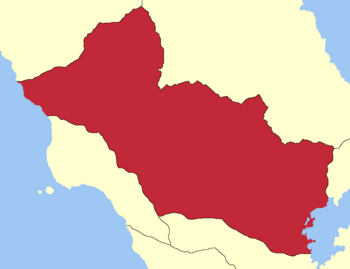United Federation: Difference between revisions
(Renamed "Aydini" to "Rafhani" →Languages) |
(Nathemba rule and the term "republic." →Etymology and official name) |
||
| Line 191: | Line 191: | ||
"United States of Iteria" (USI) was the favored name next to United Federation. It was preferred because it was shorter. Two bills were proposed to change the country's official name, one in 2007 and one in 2011. Any support for the name died in 2010 when West Zhen dictator, Emperor Kaihuang, proclaimed the United States of South Iteria (USSI) in the Zhen Civil War. | "United States of Iteria" (USI) was the favored name next to United Federation. It was preferred because it was shorter. Two bills were proposed to change the country's official name, one in 2007 and one in 2011. Any support for the name died in 2010 when West Zhen dictator, Emperor Kaihuang, proclaimed the United States of South Iteria (USSI) in the Zhen Civil War. | ||
The term "Iteria" has never been standard. Its use has been mostly in isolated instances. According to a 2019 survey, 9 out of 10 Makodyans know the name Iteria refers to the continent. The term "Makodya" was actually created by the government during the Iterian Empire in 1857 to strengthen national unity. Prior to that, people used the demonyms of their home states (i.e. Namyanon, Druznian/Drusinon, etc.). | The term "Iteria" has never been standard. Its use has been mostly in isolated instances. According to a 2019 survey, 9 out of 10 Makodyans know the name Iteria refers to the continent. The term "Makodya" was actually created by the government during the Iterian Empire in 1857 to strengthen national unity. Prior to that, people used the demonyms of their home states (i.e. Namyanon, Druznian/Drusinon, etc.). During Nathemba rule, the term "republic" became popular in local political discourse and remains in use to this day. | ||
In Prydanian, Makodya is called "Lawsfjöll" or "law mountains." The meaning has been obscure, but it has been argued it refers to Fascist Makodya's totalitarianism. Whether it was praise or criticism, it was not clear. In Santonian, Makodya is called "Macopa." The name originated from when Saintonian and Makodyan trade relations heightened in the 18th century. During Shaddanic rule, the Viceroyalty of Makopa, an Astragonese client state, controlled Makodya's only coast and, therefore, all of its ports. | In Prydanian, Makodya is called "Lawsfjöll" or "law mountains." The meaning has been obscure, but it has been argued it refers to Fascist Makodya's totalitarianism. Whether it was praise or criticism, it was not clear. In Santonian, Makodya is called "Macopa." The name originated from when Saintonian and Makodyan trade relations heightened in the 18th century. During Shaddanic rule, the Viceroyalty of Makopa, an Astragonese client state, controlled Makodya's only coast and, therefore, all of its ports. | ||
Revision as of 04:16, 9 February 2021
This article is incomplete because it is pending further input from participants, or it is a work-in-progress by one author. Please comment on this article's talk page to share your input, comments and questions. Note: To contribute to this article, you may need to seek help from the author(s) of this page. |
United Federation 5 other official names
| |||||||||||
|---|---|---|---|---|---|---|---|---|---|---|---|
|
Flag | |||||||||||
| Motto: Perpaduan adalah kekuatan, kebebasan adalah kedamaian (Old Namyanon) "Unity is strength, liberty is peace" | |||||||||||
| Anthem: "Call of the Republic" | |||||||||||
 | |||||||||||
| Capital | Salurong (executive and legislative) Tanpusqo (judicial) | ||||||||||
| Largest city | Bagumbiringan | ||||||||||
| Official languages | Zahalny-Yazk Lyulijka Namyanon Tagapa Qhicha | ||||||||||
| Demonym(s) | Makodyan | ||||||||||
| Government | Federal semi-presidential parliamentary republic | ||||||||||
• High Representative | Aisha Timuan | ||||||||||
• President of the Executive Council | Nifa Nakashad | ||||||||||
| Legislature | Supreme Batasan | ||||||||||
• Upper House | Senate | ||||||||||
• Lower House | Congress of Delegates | ||||||||||
| Formation | |||||||||||
• Pre-Imperial states | 2200 BCE-1187 CE | ||||||||||
• Biak-na-Bato Confederation | 1187-1200 | ||||||||||
• Amanikaluan dynasty | 1200-1411 | ||||||||||
• Amarlangagui dynasty | 1411-1580 | ||||||||||
• Lumay dynasty | 1580-1698 | ||||||||||
• Astragonese rule | 1 May 1698 | ||||||||||
• Iterian Empire | 3 August 1802 | ||||||||||
• Fascist Makodya | 28 April 1906 | ||||||||||
• Democratization | 20 January 1997 | ||||||||||
| Area | |||||||||||
• Total land area | 1,103,712 km2 (426,146 sq mi) | ||||||||||
| Population | |||||||||||
• 2016 census | 83,048,269 | ||||||||||
• Density | 75.2/km2 (194.8/sq mi) | ||||||||||
| GDP (PPP) | 2018 estimate | ||||||||||
• Total | 2.797 trillion IBU | ||||||||||
• Per capita | 33,679 IBU | ||||||||||
| GDP (nominal) | 2018 estimate | ||||||||||
• Total | 2.153 trillion IBU | ||||||||||
• Per capita | 25,924 IBU | ||||||||||
| Gini (2020) | 34.5 medium | ||||||||||
| HDI (2020) | very high | ||||||||||
| Currency | Lale (Ł) | ||||||||||
| Time zone | SET +2 to +4 | ||||||||||
| Date format | dd.yyyy.mm dd/yyyy/mm | ||||||||||
| Driving side | right | ||||||||||
| Internet TLD | .mkd | ||||||||||
The United Federation of Iteria, commonly known as the United Federation (U.F.I. or UFI), or Makodya, is a sovereign state stretching across from East Iteria to Central Iteria. Bounded to the west by the Meterran Sea and its northeastern frontier traces the Sunka River. It consists of 10 constituent states. Most of its 83 million citizens live in the plains. Their population centers are situated in valleys, plains, and river and lake basins. The rest of the population is spread out up in mountainous areas across 1,103,712km2 of Makodyan territory.
During the Pre-Imperial period, various enatic kingdoms and slave-trading city-states existed. Many were tributaries of the Argent Imperium until its collapse in 1187. In 1200, they formed the Tawilisi Empire. They expanded into Central Iteria and conquered Lyulijka and Qhicha states, including Astragonese territories. By the 16th Century, the Tawilisi Empire spanned far north to Craviter with colonies in Korova. Following the Shaddanic Wars, the Tawilisi Empire was dissolved. The client states of Makopa and Dyanatsia were formed. Astragonese rule lasted until 1802 when Prince Mamuwalde proclaimed the Iterian Empire.
Advised by exiled Astragonese reformists, Mamuwalde put the Iterian Empire in rapid transformation. Industrialization and agricultural reform led to prosperity. A cultural enlightenment that followed ended feudal values, notably the abolition of slavery and the caste system. In 1826, Mamuwalde established the Supreme Batasan—The oldest democratic institution in the United Federation.
1906 was the beginning of "Fascist Makodya" ruled by Thassad Nabantuwe with the Nathemba Party. The Nathemba imposed totalitarian rule and suppressed all forms of opposition. After a 1921 coup, they abolished the monarchy to establish a military dictatorship. They banned religion, subsidized economic modernization, provided state support for scientific racialism, and legislated the Yamanglahi Laws. Yamanglahi was a series of eugenics policies that targeted "undesirables." The Nathemba considered the Hailakaid peoples the most superior human race. Hailakurash (ሓኢላኩራሽ, lit. Hailakaid supremacy) was an attempt to establish a pure Hailakaid race by assimilating other cultures through interbreeding.
Nathemba was overthrown in the 1980 People Power Revolution. Although the eugenics policies were abolished, a system of minority rule was established. Fabricated justification on the population's lack of education in democratic process hid strong racist tendencies that persisted thanks to years of scientific racialism. Minority rule disenfranchised the majority population until its end in 1997. The restoration of majority rule established a liberal democracy under the United Federation.
Etymology and official name
According to the UFI Constitution, "United Federation of Iteria" is the official name. There is also an official name in each of the country's 5 official languages. Short form names commonly used are the "United Federation," "U.F.I.," and "UFI." The term "Makodya" is used as an alternative term in reference to the United Federation. It is a portmanteau of "Makopa" and "Dyanatsia", client states of the Astragonese Empire. These were artificial nations created from conquered territories of the former Tawilisi Empire. It existed from 1698 until 1802, when the Iterian Empire was established.
"United States of Iteria" (USI) was the favored name next to United Federation. It was preferred because it was shorter. Two bills were proposed to change the country's official name, one in 2007 and one in 2011. Any support for the name died in 2010 when West Zhen dictator, Emperor Kaihuang, proclaimed the United States of South Iteria (USSI) in the Zhen Civil War.
The term "Iteria" has never been standard. Its use has been mostly in isolated instances. According to a 2019 survey, 9 out of 10 Makodyans know the name Iteria refers to the continent. The term "Makodya" was actually created by the government during the Iterian Empire in 1857 to strengthen national unity. Prior to that, people used the demonyms of their home states (i.e. Namyanon, Druznian/Drusinon, etc.). During Nathemba rule, the term "republic" became popular in local political discourse and remains in use to this day.
In Prydanian, Makodya is called "Lawsfjöll" or "law mountains." The meaning has been obscure, but it has been argued it refers to Fascist Makodya's totalitarianism. Whether it was praise or criticism, it was not clear. In Santonian, Makodya is called "Macopa." The name originated from when Saintonian and Makodyan trade relations heightened in the 18th century. During Shaddanic rule, the Viceroyalty of Makopa, an Astragonese client state, controlled Makodya's only coast and, therefore, all of its ports.
History
Early Pre-Imperial (Pre-200)
Evidence of the first humans in Makodya were dated 500,000 years ago in lands now known as eastern United Federation near Lake Barētdelan. Remains of an extinct human pygmy species, Homo tagapanensis, were found in Kalaw Cave. This species is believed to have lived up until their extinction 50,000 to 67,000 years ago. But the oldest modern human remains were found in the Tabon Caves of Lipuun Point, dated to 16,000-18,000 years ago. In the cave complex, archeologists found pottery, jade jewelry, and stone tools. Animal bones found in intricately-designed burial jars were dated 17,000 years old. Signs of near continuous habitation in the caves even indicate they have been there since 10,000 years ago.
In the plains surrounding Lake Barētdelan, the first signs of civilization have been dated to 2,000 years ago. The Lyulijka, descendants of the Ano'an and Sinnitic migration, settled near the lake. Excavated sites in the Makodyan east revealed tools and jewelry made out of bones and precious stones. The cultural behavior of the early Makodyans exhibited communal living and warlike tendencies, before a transition to a pacifistic lifestyle. They eventually learned how to cultivate the land, domesticate animals, and founded settlements towards the 1st Century CE. Most of them returned to nomadism roaming the mountain river valleys of mideastern United Federation. Although most became sedentary, many still preferred nomadic herding. These mountain nomads would later become the Qhicha people.
Ano'an and Sinnitic migration continued throughout Iteria and eventually arrived in western United Federation. There, they encountered descendants of the Hailakaid migration from 7,000 years earlier. They spoke a lost non-standard form of Ubgandian with little evidence on copperplate inscriptions. The Ano'ans and Sinnitics assimilated with the Hailakaid population resulting into the modern Tagapa people. Influenced by neighboring early Astragonese society, the Tagapa people lived as hunter-gatherers organized into warrior tribal confederations. Matriarchal and religious traits of pre-Zhen Riko people were inherited by the new Tagapa culture. Lumanbarangay, a proto-caste feudalistic system, relied on a trifunctional stratification based on three castes: Priestesses, warriors, and commoners. Leadership depended on an elite priesthood ruled by feudal matriarchal clans. Like Riko priestesses, they led shamanistic worship to nature spirits. The unique difference was Tagapanon priestesses regularly offered blood sacrifices. Criminals and kidnapped, unwanted individuals were also sacrificed. Warrior clans, though also enatic, relied on male commanders. They helped the priesthood control warriors, who were mostly men. Warriors were also used as extra labor to quicken construction of village defenses and improvements.
Rice was introduced by Skandan traders in 1500 BCE. Most commoners became farmers, tending in rice fields and served at the pleasure of the priesthood and warrior castes. The rice culture reached Eastern Makodya by 1350 BCE.
By 1000 BCE, the inhabitants of Makodya developed warring hunter-gatherer tribes, mountain valley plutocracies, and littoral principalities.
Late Pre-Imperial (200-1200)
By the 7th Century, Tagapanon coastal settlements have emerged as trade centers. In 592 CE, Syrixian traders arrived in the Makodyan coast. They usually travelled with scholars and Rakani priests. This marked the beginning of the Tagapa renaissance, when Tagapanon society acquired from foreign traders various cultural characteristics to form the basis of modern Tagapanon culture. The first phase of the renaissance involved the "samrajicization" of Old Tagapanon culture. The modern Tagapa language and writing system was derived from Suchari. The fusion of Rakanism with pre-existing Tagapanon folk religions and animist beliefs led to the creation of Diwanism.
It did not take long before Tagapanon traders brought Syrixian influences to the Qhicha and Lyuli cultures. Several Suchari loanwords and influences could be observed in the Lyuli language. New farming techniques allowed the Qhicha people to cultivate rougher terrain in the foothills of both Pukaranras and Chumpas mountain ranges. The Qhicha highland plutocracies prospered and became warring kingdoms, fighting for new territory due to the limited fertile and habitable land. Lyuli towns surrounding the lake grew into thalassocratic principalities. They traded with neighboring Alnaria, TBD, and TBD. TBD ALNARIAN INFLUENCE
Demographics
Languages
| Language | Speakers | ||
|---|---|---|---|
| Tagapa | 36.92 % | 30,665,089 | |
| Qhicha | 24.70 % | 20,512,453 | |
| Lyulijka | 17.79 % | 14,773,536 | |
| Namyanon | 7.31 % | 6,074,655 | |
| Zahalny-Yazk | 4.39 % | 3,645,660 | |
| Other foreign languages/(local) dialects | 8.83 % | 7,336,534 | |
| Not reported/not stated | 0.05 % | 40,342 | |
| TOTAL | 83,048,269 | ||
| Source: UFI Census Bureau, 2016 | |||
The five official and national languages of the United Federation are Zahalny-Yazk, Lyulijka, Namyanon, Tagapa, and Qhicha. In addition, there are 13 local individual dialects. There used to be eight other official languages but they have been determined extinct upon the ratification of the 1997 UFI Constitution. Provided in the Constitution are also the language regulators of Tagapa and Qhicha. They formulate rules, officiate new words, and enforce the standardization of both languages. For Tagapa, the language regulator is the Institut ng Wikang Tagapa (Institute of the Tagapa Language). For Qhicha, it is the Quraq Suntur Qhicha Simi (High Academy of the Qhicha Language).
Tagapa and Qhicha are the primary languages of the country. Historically, Tagapa has been the sole administrative language. Under Fascist Makodya, it was reinforced due to the Yamanglahi Laws, which banned the use of other languages. Qhicha and other languages returned to government use after the 1980 People Power Revolution. Both Tagapa and Qhicha languages are used in government, education, print, broadcast media, and business, usually with a third local language or dialect. Constituent states have recognized and promoted the use of local languages and dialects. Mercanti has been promoted for use in the private sector and urban areas due to globalization. The Hailesha language, though it lost its official status in 1997, is used by the elite. Hailesha has been strongly associated with the old rich. The nouveau riche is stereotypically identified with Mercanti. Religious languages such as Rafhani and Yiddish are taught, respectively, in Mehrabist and Shaddaist schools.
Astragonese Makodyans speak dialects from their province of origin. These dialects are Bhadari, Na Themba, and Neo Hailasse. The North Bhadari Autonomous Region in Qulla officially uses North Bhadari, also an Hailesha dialect. Mansini Makodyans also speak the Astragonese languages as well as the Mansini languages such as Wursuufan, Sanulama, and Fussian.
The UFI Constitution mandated the Tagapa Sign Language as the official sign language of the United Federation to be used as a medium of communication and instruction with the deaf and their education.
Culture
National anthem
Voice of Iteria, also known as the Call of the Republic, is the national anthem of the United Federation. The song was written and composed by Koja Naketa, a Messianist preacher, for the 1902 Makodyan Centennial Celebrations. It became associated with Pan-Iterianist and civil rights movements in the late 1920s and early 1980s. There was no official national anthem and another song, Bayan Ko, was alternatively used. Despite its early use, Voice of Iteria has been the popular choice for a national song in public events under Fascist Makodya. But new lyrics were written in 1922 by Col. Biko Bawale, Head of the Barongan (Fascist Makodya secret police). Unlike the original, the new lyrics was only sung in Tagapa. The 1902 lyrics was restored when the song was finally adopted in 1997 when the UFI Constitution was formally ratified. It is sung in all the five official languages.
Ringing out from our blue heavens, |
In our body and our spirit, |






